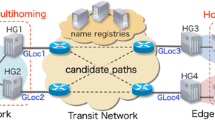Abstract
In heterogeneous network environments, the network connections of a multi-homed device may have significant bandwidth differential. For a multi-homed transmission protocol designed for network failure tolerance, such as SCTP, path selection algorithms for data transmission drastically affect performance. This article studies the effect of path bandwidth differential on the performance of retransmission strategies in multi-homing environments. It identifies that fast retransmission on an alternate path may cause receive buffer blocking when path bandwidth differential is significant and the receive buffer is limited. A theoretical model is proposed for selecting retransmission path during the fast retransmission phase, based on receive buffer and path conditions. From these observations and analysis results, this article proposes that path selection strategies for transmitting new data and retransmitted data should be decoupled. A new path selection scheme is proposed and evaluated through SCTP simulations.
Access this article
We’re sorry, something doesn't seem to be working properly.
Please try refreshing the page. If that doesn't work, please contact support so we can address the problem.
Similar content being viewed by others
Explore related subjects
Discover the latest articles, news and stories from top researchers in related subjects.References
Dutta, A., Das, S., Famolari, D., Ohba, Y., Taniuchi, K., Kodama, T., & Schulzrinne, H. (2005). Seamless handoff across heterogeneous networks—an 802.21 centric approach. In Proceedings of the IEEE WPMC 2005, Aalborg Denmark, September 2005.
Nordmark, E., & Bagnulo, M. (2008). Shim6: level 3 multihoming shim protocol for IPv6. IETF draft, February 2008. http://www.ietf.org/internet-drafts/draft-ietf-shim6-proto-10.txt.
Moskowitz, R., & Nikander, P. (2006). Host identity protocol (HIP) architecture. In IETF RFC 4423, May 2006.
Kohler, E., Handley, M., & Floyd, S. (2006). Datagram congestion control protocol (DCCP). In IETF RFC 4340, March 2006.
Stewart, R. Ed., (2007). Stream control transmission protocol. In IETF RFC 4960, September 2007.
Caro, A. Jr., Amer, P., & Stewart, R. (2004). Retransmission schemes for end-to-end failover with transport layer multihoming. In GLOBECOM 2004, November 2004.
Stewart, R., & Xie, Q. (2006). Stream control transmission protocol (SCTP), a reference guide. Reading: Addison-Wesley.
Noonan, J., Perry, P., Murphy, S., & Murphy, J. (2006). Stall and path monitoring issues in SCTP. In Proceedings of IEEE Infocom, conference on computer communications, Barcelona, April 2006.
Iyengar, J., Shah, K., & Amer, P. (2004). Concurrent multipath transfer using sctp multihoming. In SPECTS’04, San Jose, USA, July 2004.
Iyengar, J., Amer, P., & Stewart, R. (2005). Receive buffer blocking in concurrent multipath transfer. In IEEE Globecom 2005, St. Louis, November 2005.
Ladha, S., Baucke, S., Ludwig, R., & Amer, P. (2004). On making SCTP robust to spurious retransmissions. ACM Computer Communication Review, 34(2).
Caro, A., & Iyengar, J. ns-2 SCTP module, version 3.5. http://www.armandocaro.net/software/ns2sctp/.
UC Berkeley, LBL, USC/ISI, and Xerox Parc (2005). ns-2 documentation and software, version 2.29, October 2005, www.isi.edu/nsnam/ns.
Carter, R. L., & Crovella, M. E. (1996). Measuring bottleneck link speed in packet-switched networks. Performance Evaluation, 27, 297–318.
Casetti, C., Gerla, M., Mascolo, S., Sanadidi, M., & Wang, R. (2002). TCP Westwood: bandwidth estimation for enhanced transport over wireless links. ACM Wireless Networks, 8, 467–479.
Author information
Authors and Affiliations
Corresponding author
Additional information
This Research Programme is supported by Enterprise Ireland through its Applied Research Enhancement fund and the National Natural Science Foundation of China under Grants No. 60873258.
Rights and permissions
About this article
Cite this article
Qiao, Y., Fallon, E., Murphy, J. et al. Transmission scheduling for multi-homed transport protocols with network failure tolerance. Telecommun Syst 43, 39 (2010). https://doi.org/10.1007/s11235-009-9195-4
Published:
DOI: https://doi.org/10.1007/s11235-009-9195-4




